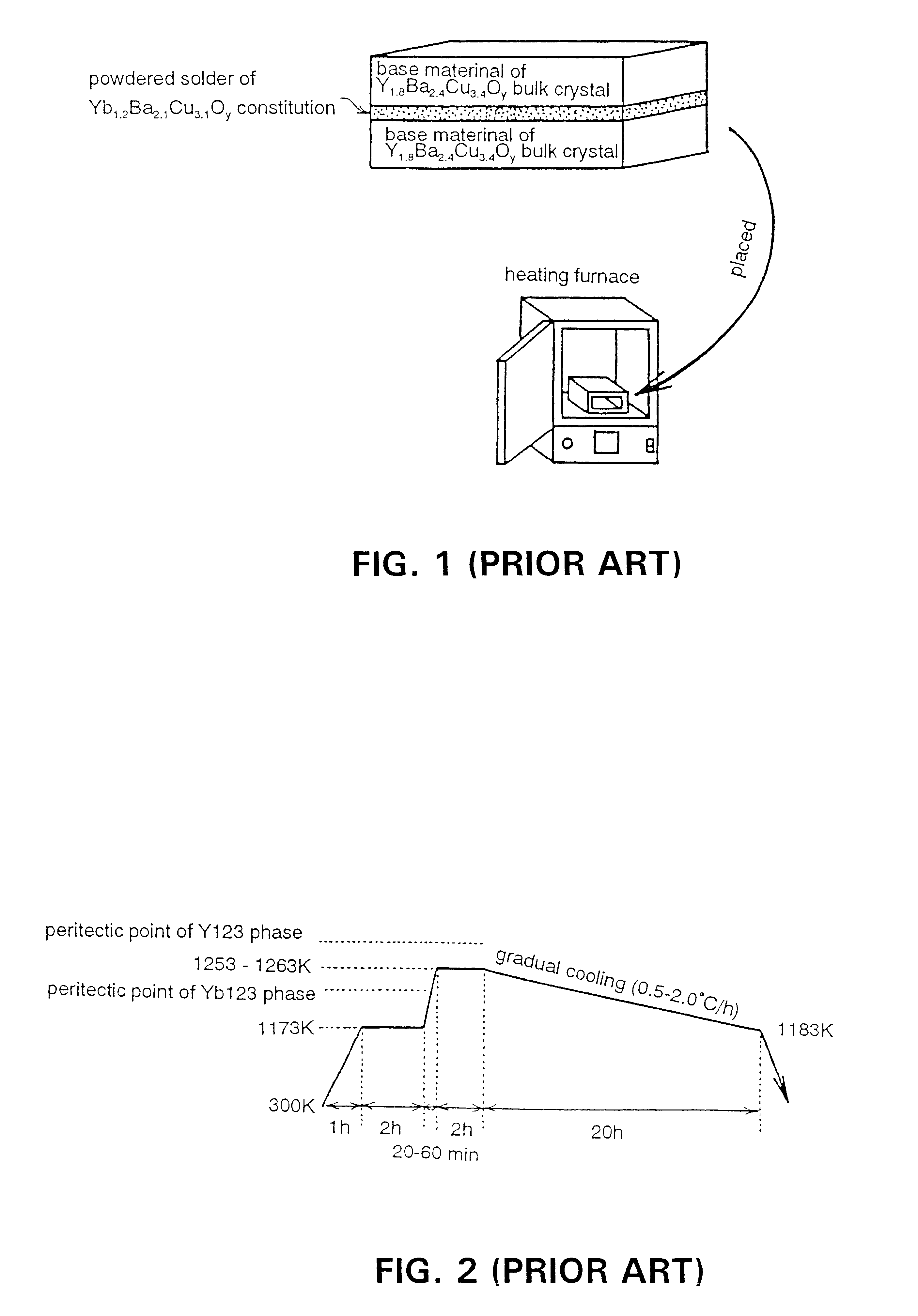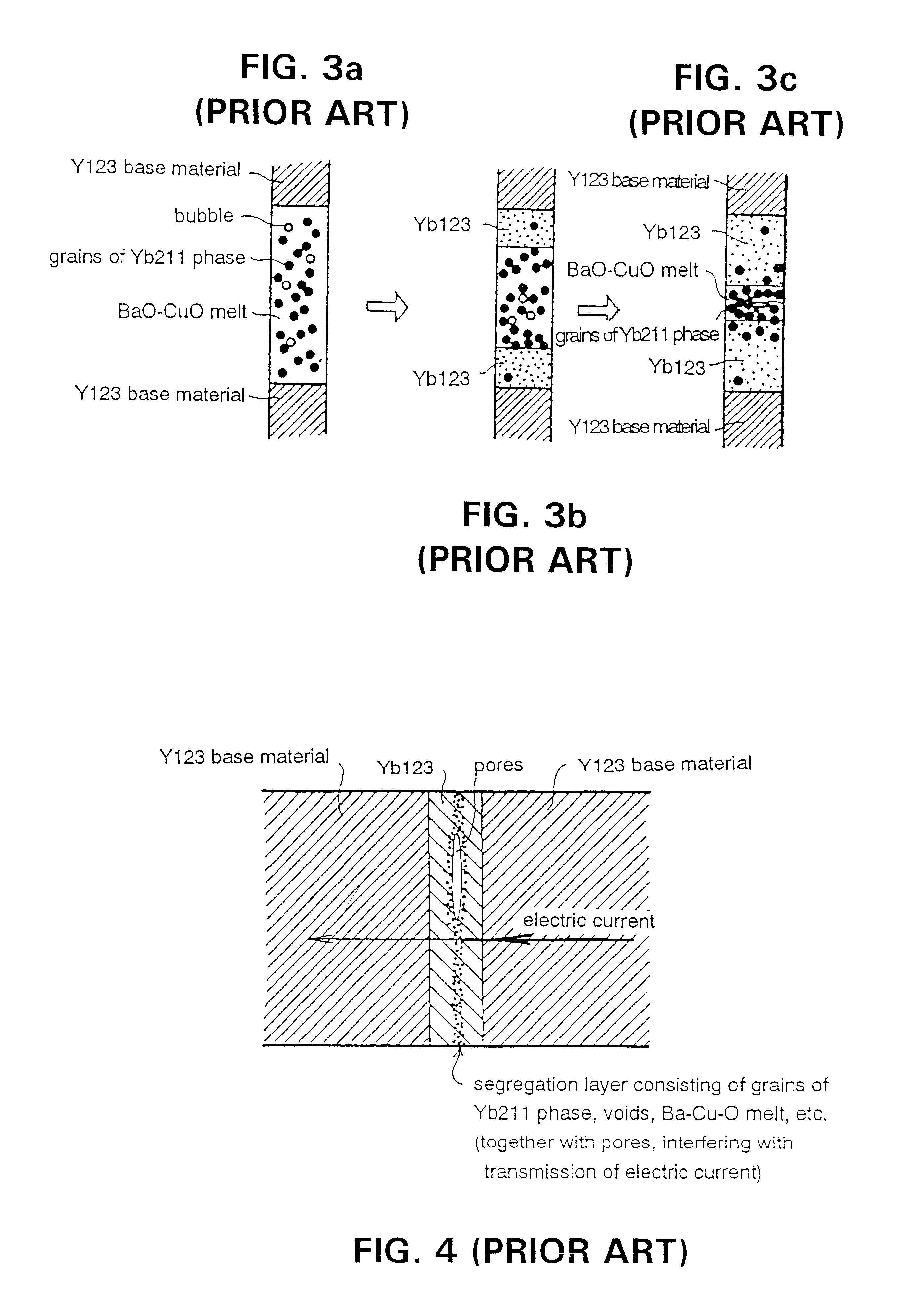Method of joining together superconductors and a superconductor joined member produced by same
a superconductor and superconductor technology, applied in the direction of superconductor devices, manufacturing tools, solvents, etc., can solve the problems of inability to exhibit fully satisfactory performance, lack of plasticity, and inability to lead superconducting current lead wire and superconducting wire rod, etc., to achieve excellent current transmission performance
- Summary
- Abstract
- Description
- Claims
- Application Information
AI Technical Summary
Benefits of technology
Problems solved by technology
Method used
Image
Examples
reference example 1
First, Y 123 superconducting bulk crystals (Y.sub.1.8 Ba.sub.2.4 Cu.sub.3.4 O.sub.y) were prepared by a melt-solidifying process.
In the next step, a square member was cut from the Y 123 superconducting bulk crystals, respectively, by machining, and an attempt was made to join together two pieces of the square members as base materials to be joined together by use of a solder.
For the solder for use in a joining process, powders (powders of Yb211+Ba.sub.3 Cu.sub.5 O.sub.x) of Yb 123 superconducting material (Yb.sub.1.2 Ba.sub.2.1 Cu.sub.3.1 O.sub.y) constitution were used.
When joining together the base materials, the base materials were first laid such that a side face of one of the base materials, at one end thereof, was kept in intimate contact with a side face of another of the base materials, at one end thereof, so as to overlap each other as shown in FIG. 8, and the solder in powder form was overlaid on top of the overlapped part of the base materials so as to straddle both the b...
reference example 2
First, Nd 123 superconducting bulk crystals (NdBa.sub.2 Cu.sub.3 O.sub.y) were prepared by a melt-solidifying process.
In the next step, a square member was cut from the Nd 123 superconducting bulk crystals, respectively, by machining, and an attempt was made to join together two pieces of the square members as base materials to be joined together by use of a solder.
For the solder for use in a joining process, powders (powders of Sm 211+Ba.sub.3 Cu.sub.5 O.sub.x) of Sm 123 superconducting material (SmBa.sub.2 Cu.sub.5 O.sub.y) constitution were used.
When joining together the base materials, the respective base materials were first cleaved at one end thereof as shown in FIG. 10 (a), exposing respective cleavage surfaces (ab faces), and thereafter, a portion of the end of one of the base materials was cut off as shown in FIG. 10 (b).
Then, the end of the one of the base materials, rendered in such a condition as above, was butted at the end of the other base material as shown in FIG. 10...
PUM
| Property | Measurement | Unit |
|---|---|---|
| superconducting | aaaaa | aaaaa |
| superconductor | aaaaa | aaaaa |
| non-superconducting | aaaaa | aaaaa |
Abstract
Description
Claims
Application Information
 Login to View More
Login to View More - R&D
- Intellectual Property
- Life Sciences
- Materials
- Tech Scout
- Unparalleled Data Quality
- Higher Quality Content
- 60% Fewer Hallucinations
Browse by: Latest US Patents, China's latest patents, Technical Efficacy Thesaurus, Application Domain, Technology Topic, Popular Technical Reports.
© 2025 PatSnap. All rights reserved.Legal|Privacy policy|Modern Slavery Act Transparency Statement|Sitemap|About US| Contact US: help@patsnap.com



